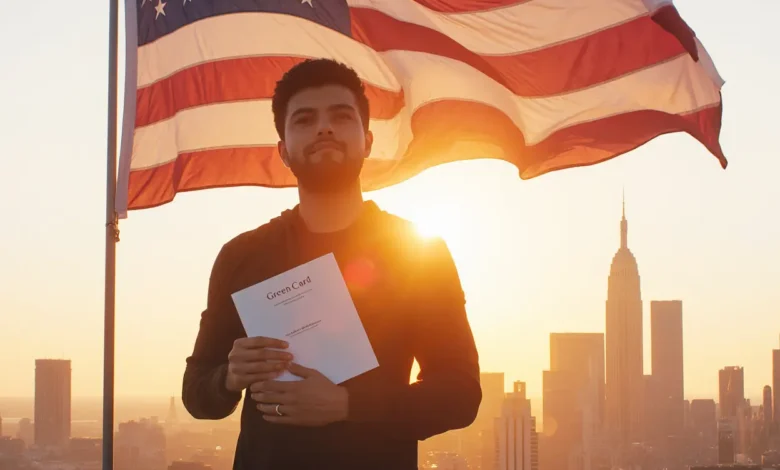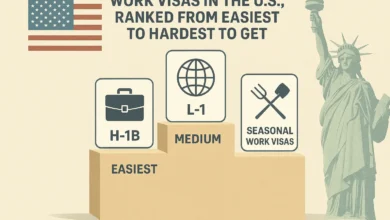So You Want a Green Card? Here’s What Nobody Tells You

Are you considering making America your permanent home? Many are drawn to the prospect of obtaining a Green Card, which can provide significant opportunities. However, the process of obtaining a Green Card is far more complex than many realize.
I’ve helped people through this process for years, and there’s a lot that often goes unsaid. Getting a Green Card can take anywhere from a few months to over a decade, and the path you choose really matters. Don’t worry, I’m here to show you what it actually takes to become a U.S. permanent resident.
Whether you’re already working with a US work visa, studying here, or just starting to explore your options, this guide will give you the real scoop on the Green Card process.
Table of Contents
What Exactly Is a Green Card (And Why Everyone Wants One)
⚽ Be One of the 5 Lucky Winners! Join the World Cup 2026 “Green Card” Challenge
Answer 10 easy questions, engage with us, and play for fun! ✨
Disclaimer: This challenge is for fun and awareness only. Volunteering at the FIFA World Cup does not provide U.S. permanent residency. The mention of “win a Green Card” is a playful hook and not an official offer.
Let’s start with the basics. A Green Card is officially called a “Permanent Resident Card,” and it’s your ticket to living and working anywhere in the United States indefinitely. Think of it as the VIP pass to American life.
Here’s what makes it so special:
- Work freedom: No more being tied to a specific employer or scrambling for visa renewals
- Travel flexibility: You can leave and return to the US without the stress of visa applications
- Path to citizenship: After five years (or three if married to a US citizen), you can apply to become an American citizen
- Family benefits: You can sponsor certain family members for their own Green Cards
What shocked me at first: there are several ways to get a Green Card—some much easier than others.
With that in mind, let’s talk about how people actually get a Green Card. The main pathways are a lot more varied than most expect:
This is how about 65% of people get their Green Cards. If you have family in the US, you might be in luck. Here’s the breakdown:
Immediate relatives (no waiting list):
- Spouses of US citizens
- Unmarried children under 21 of US citizens
- Parents of US citizens (if the citizen is over 21)
Family preference categories (with waiting periods):
- Unmarried adult children of US citizens
- Spouses and children of permanent residents
- Married children of US citizens
- Siblings of US citizens
Pro tip: Wait times for family preference categories can stretch to over 10 years for some countries. Immediate relatives might get a Green Card in 8 to 15 months. The speed of the family route depends a lot on your relationship.
Employment-Based Green Cards: For the Career-Focused
If you’re established professionally or have skills America needs, this could be your path. There are five main categories:
- EB-1: Priority workers (think Nobel Prize winners, multinational executives)
- EB-2: Professionals with advanced degrees or exceptional ability
- EB-3: Skilled workers and professionals
- EB-4: Special immigrants (religious workers, certain government employees)
- EB-5: Investors (minimum $800,000 investment required)
EB-1 applicants often do not have to wait. For EB-2 and EB-3, the process is more complicated, especially for people from India or China. The category you apply under and your nationality have a big impact on your timeline.
Green Card Lottery: Your Annual Shot at Luck
The Diversity Visa Lottery gives 55,000 Green Cards annually to people from countries with low U.The catch? Not everyone can apply. If you’re from countries like India, China, Mexico, or the UK, you cannot enter because many people from these countries already move to the US.dy immigrate to the US.
If you qualify, go ahead and apply. It’s basically free except for a small processing fee, and it only takes about 10 minutes online. I always tell clients: Just do it. What’s the worst that could happen?
The Two Ways to Actually Get Your Green Card
Once you’ve figured out which pathway works for you, there are two ways to complete the process:
Adjustment of Status: The Stay-at-Home Option
Already in the U.S. on a valid visa? Adjustment of Status lets you switch to permanent resident without leaving. It’s convenient, but you must maintain legal status throughout.
Allowing your work visa to lapse while your Green Card application is pending can jeopardize your case. Maintain valid status at all times to avoid preventable setbacks.
Consular Processing: The Travel Route
Consular Processing means applying through a U.S. consulate in your home country. It’s often faster than Adjustment of Status, but you’ll attend an interview abroad and enter the U.S. with your immigrant visa.
The downside? If something goes wrong, you’re stuck outside the US until it gets sorted out. Key takeaway: Consular processing can mean delays if issues arise abroad.
What Nobody Tells You About the Real Costs
Government filing fees are listed ($1,200-$2,000+), but hidden costs are what matter most.
Hidden expenses include:
- Medical examinations ($200-$500)
- Translation services for foreign documents ($50-$200 per document)
- Travel costs for consular processing (varies widely)
- Lost income if you can’t work during status gaps
- Attorney fees ($3,000-$15,000+ for complex cases)
My friend Sarah tried to save money by handling her family-based petition on her own. After three rejections and two years, she finally hired a lawyer. In the end, those savings cost her $5,000 more and years of waiting. Getting professional help can save you time and money in the long run.
The Waiting Game: Timeline Reality Check
Processing times vary widely and depend on factors such as: your country of birth (not citizenship!), pathway, USCIS workload, and application completeness.
- Which pathway you’re using
- Current USCIS workload
- Completeness of your application
If you’re from India applying for an EB-2 Green Card, expect an 8-10 year wait. Applicants from Europe may get the same Green Card in under two years. Key takeaway: Country of birth has a massive impact on wait times.
Common Mistakes That Derail Applications
I’ve seen smart, successful people make these mistakes over and over:
Not maintaining status
Your visa status is fragile. One mistake can cause everything to fall apart. Always keep your status valid while your Green Card is pending.
Incomplete documentation
USCIS does not give second chances for missing paperwork. They will deny your application, so triple-check everything.
Trying to DIY complex cases
Simple family cases? Maybe handle them yourself. Complicated employment cases? Hire a pro. It’s not worth the risk. Key takeaway: It’s smart to get expert help for complicated situations.
Life After the Green Card: What Changes (And What Doesn’t)
Getting a Green Card feels amazing, but it’s just the start. You’ll need to:
- File US tax returns on worldwide income (yes, even if you live abroad temporarily)
- Maintain US residence (don’t stay outside the US for more than 6 months without planning)
- Renew your card every 10 years (though your status is permanent)
- Consider citizenship after 5 years if you want voting rights and a US passport
The freedom you gain is amazing. You no longer have to worry about visa renewals, job restrictions, or travel stress. In almost every way, you are American except for voting.
Smart Strategies for Success
Based on what I’ve seen work (and what definitely doesn’t), here are my top recommendations:
Start early and stay organized
Immigration is a marathon. Create a timeline, gather your documents early, and keep track of everything. Make copies of all your paperwork.
ConsiderTry not to rely on just one option. If you are eligible, apply for the Green Card Lottery while also looking into other paths. Explore both family and employment routes if you qualify.utes if you qualify.
Get professional help for complex situations
If you have any complications such as previous visa violations, a criminal history, or a complex family situation, invest in a good immigration attorney from the start.
Stay patient but persistent
The process is slow and sometimes frustrating. But giving up means starting over. Stay on top of deadlines, respond quickly to requests, and keep pushing forward. Key takeaway: Persistence and organization are essential for success.
Frequently Asked Questions
Q: How long does it take to get a Green Card? A: It depends entirely on your pathway and country of birth. Family-based for immediate relatives of US citizens typically takes 8-15 months. Employment-based can range from 1-10+ years depending on your category and country.
Q: Can I travel while my Green Card application is processing? A: If you’re doing Adjustment of Status, you’ll need advance parole to travel safely. With consular processing, travel is generally fine until you attend your interview.
Q: What happens if my Green Card application gets denied? A: It depends on your current status and the reason for denial. You might be able to appeal, refile, or you might need to leave the US. This is why legal advice is crucial.
Q: Do I need to speak English to get a Green Card? A: No, there’s no English requirement for the Green Card itself. However, you’ll need English for the citizenship test later if you choose that path.
Q: Can I apply for a Green Card if I’m undocumented? A: It’s complicated and depends on your specific situation. Some pathways allow for forgiveness of unlawful presence, but others don’t. Definitely consult with an immigration attorney.
Q: How much money do I need in the bank for a Green Card? A: There’s no specific requirement for most Green Cards, but you’ll need to show you won’t become a “public charge.” This typically means having adequate financial support through employment, family, or assets.
Your Next Steps: Making It Happen
So there you have it, the real story on getting your Green Card. It is not always easy, and it is definitely not quick, but you can do it with the right approach.
If you’re serious about this journey, start by honestly evaluating which pathway makes the most sense for your situation. Check out our detailed guides on work visas if you’re employment-focused, or learn more about the Green Card Lottery if you’re eligible.
Getting a Green Card is more than just filling out paperwork. It is a big step toward building a new life in the United States. Move forward carefully, be patient, and get help when you need it. Success comes from perseverance and asking for support when needed.
The American dream is still alive and kicking. Your Green Card might just be the key to unlocking it.

